

|
| UNITED STATES OF AMERICA | |
| MISSOURI | |
| Saint Louis City County |
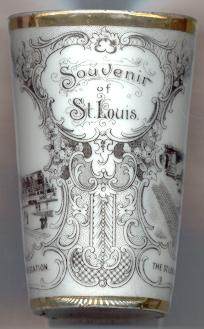 The history of modern Saint Louis began in 1763, when the French fur trader Pierre Laclède (or P. Laclède Liguest), chose the west bank of the Mississippi
just below the Missouri as the site for a fur-trading post, mistakenly believing that the land belonged to France. France, however, had already ceded all territory
west of the Mississippi to Spain in a treaty the year before. St. Louis was named after Louis IX, the Crusader King of France who ruled between 1214 and 1270 and was canonized in 1297.
Although the land formally belonged to Spain, the culture remained French. With the onset of the American Revolution in 1776, France and Spain joined the United States in the fight against Britain.
After France had regained the Louisiana territory by the secret Treaty of San Ildefonso in 1800, Thomas Jefferson (1743–1826), 3rd President (1801–1809) of the United States,
purchased the land from Napoleon Bonaparte for $15 million in 1803 (the "Louisiana Purchase", see map).
The territory stretched from the Mississippi to the Rocky Mountains and from the Gulf of Mexico to the Canadian border, an area of 828,000 square miles.
This act marks the beginning of the Western Expansion. The Missouri Compromise of 1820 admitted Missouri into the Union as a slave state contingent to the admittance of Maine as a free state.
Slavery was forbidden in all future states north and west of Missouri. With the beginning of the Civil War of 1861, St. Louis remained divided in its sympathies.
The Union, however, gained control of the city by mid 1861. The war also helped to change the economy from steamboat trade to the railroad industry.
The centennial of the Louisiana Purchase was celebrated with the St. Louis World's Fair or Louisiana Purchase Exposition in 1904. The first international air meet
was held in 1910. Aeroplane industry started in 1939 with McDonnel (merged with Douglas in 1967, today taken over by Boeing in 1997). After World War II,
Franklin Delano Roosevelt (1882–1945), 32nd President (1933–1945) of the United States, proposed a national monument in St. Louis. The design competition was won by the Finnish architect
Eero Sarinen. His 630 ft (192 m) stainless steel arch was built 1963–1966.
The history of modern Saint Louis began in 1763, when the French fur trader Pierre Laclède (or P. Laclède Liguest), chose the west bank of the Mississippi
just below the Missouri as the site for a fur-trading post, mistakenly believing that the land belonged to France. France, however, had already ceded all territory
west of the Mississippi to Spain in a treaty the year before. St. Louis was named after Louis IX, the Crusader King of France who ruled between 1214 and 1270 and was canonized in 1297.
Although the land formally belonged to Spain, the culture remained French. With the onset of the American Revolution in 1776, France and Spain joined the United States in the fight against Britain.
After France had regained the Louisiana territory by the secret Treaty of San Ildefonso in 1800, Thomas Jefferson (1743–1826), 3rd President (1801–1809) of the United States,
purchased the land from Napoleon Bonaparte for $15 million in 1803 (the "Louisiana Purchase", see map).
The territory stretched from the Mississippi to the Rocky Mountains and from the Gulf of Mexico to the Canadian border, an area of 828,000 square miles.
This act marks the beginning of the Western Expansion. The Missouri Compromise of 1820 admitted Missouri into the Union as a slave state contingent to the admittance of Maine as a free state.
Slavery was forbidden in all future states north and west of Missouri. With the beginning of the Civil War of 1861, St. Louis remained divided in its sympathies.
The Union, however, gained control of the city by mid 1861. The war also helped to change the economy from steamboat trade to the railroad industry.
The centennial of the Louisiana Purchase was celebrated with the St. Louis World's Fair or Louisiana Purchase Exposition in 1904. The first international air meet
was held in 1910. Aeroplane industry started in 1939 with McDonnel (merged with Douglas in 1967, today taken over by Boeing in 1997). After World War II,
Franklin Delano Roosevelt (1882–1945), 32nd President (1933–1945) of the United States, proposed a national monument in St. Louis. The design competition was won by the Finnish architect
Eero Sarinen. His 630 ft (192 m) stainless steel arch was built 1963–1966.
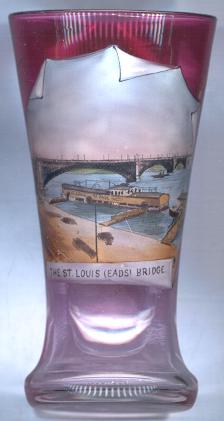
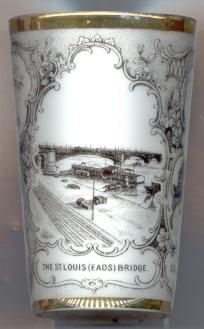
The  Eads Bridge (St. Louis Bridge, or Illinois and St. Louis Bridge) was the first bridge to span
the Mississippi river. It was designed and built by James Buchanan Eads (1820–1887) as the world's first successful steel arch bridge. Construction started in 1867 and was completed in 1874.
The length of the center span is 520 ft (158.5 m) with a clearance of 59 ft (18 m).
In 1879, the famous American writer Walt Whitman wrote: "I have haunted the river every night lately, where I could get a look at the bridge by moonlight.
It is indeed a structure of perfection and beauty unsurpassable, and I never tire of it."
The upper (road) deck of the bridge was closed for traffic in 1991 and was removed in 1995, while trains continued to use the lower deck.
A building project aimed at rebuilding the upper deck by 1999.
Eads Bridge (St. Louis Bridge, or Illinois and St. Louis Bridge) was the first bridge to span
the Mississippi river. It was designed and built by James Buchanan Eads (1820–1887) as the world's first successful steel arch bridge. Construction started in 1867 and was completed in 1874.
The length of the center span is 520 ft (158.5 m) with a clearance of 59 ft (18 m).
In 1879, the famous American writer Walt Whitman wrote: "I have haunted the river every night lately, where I could get a look at the bridge by moonlight.
It is indeed a structure of perfection and beauty unsurpassable, and I never tire of it."
The upper (road) deck of the bridge was closed for traffic in 1991 and was removed in 1995, while trains continued to use the lower deck.
A building project aimed at rebuilding the upper deck by 1999.
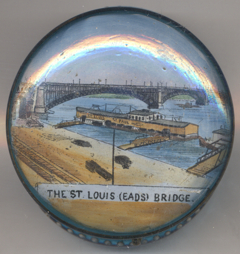
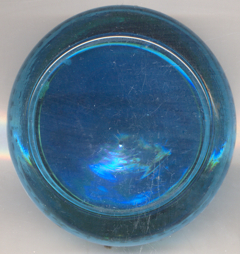
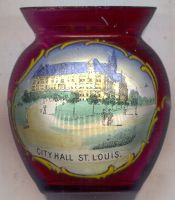
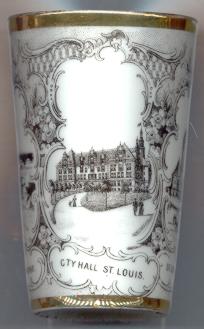
The  City Hall of St. Louis was built after a competition held in 1890. The competition was won by the architects
Edmond J. Eckel and George R. Mann of St. Joseph, MO, with a design in French Renaissance Revival style. Problems with financing delayed the completion of the construction and it was
not until the late 1890's that it was occupied. It was finally completed by Albert B. Groves of St. Louis with a marble rotunda and grand staircase in time for the 1904
World's Fair. A central tower and two flanking spires were removed in 1936.
City Hall of St. Louis was built after a competition held in 1890. The competition was won by the architects
Edmond J. Eckel and George R. Mann of St. Joseph, MO, with a design in French Renaissance Revival style. Problems with financing delayed the completion of the construction and it was
not until the late 1890's that it was occupied. It was finally completed by Albert B. Groves of St. Louis with a marble rotunda and grand staircase in time for the 1904
World's Fair. A central tower and two flanking spires were removed in 1936.
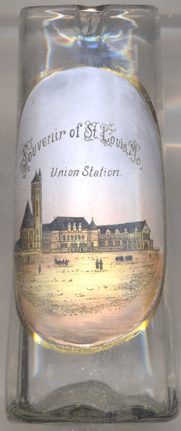
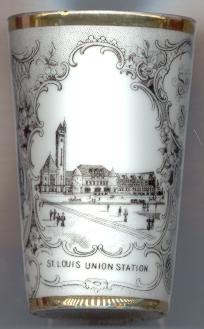
 St. Louis Union Station was once the largest and busiest passenger rail terminal in the world.
Union Station first opened in 1894. It was built in an eclectic mix of Romanesque styles after plans of the German-born architect
Theodore C. Link of St. Louis who won the prized project in a nationwide contest.
A most impressive feature of the Grand Hall is the "Allegorical Window," a hand-made stained glass window with hand-cut Tiffany glass
strategically positioned above the Station's main entryway. The window features three women representing the main U.S. train stations
during the 1890s: New York, St. Louis and San Francisco.
In 1976, the Saint Louis Union Station was designated a National Historic Landmark. However, it ceased operation as an active trains station in 1978.
After an extensive restoration and re-adaptation it re-opened in 1985. It now houses shopping malls, restaurants,
a Marriott Hotel, a 10-screen movie theatre, luxury offices, a lake, 4 active train tracks
and a plaza for festivals, concerts and other special events.
St. Louis Union Station was once the largest and busiest passenger rail terminal in the world.
Union Station first opened in 1894. It was built in an eclectic mix of Romanesque styles after plans of the German-born architect
Theodore C. Link of St. Louis who won the prized project in a nationwide contest.
A most impressive feature of the Grand Hall is the "Allegorical Window," a hand-made stained glass window with hand-cut Tiffany glass
strategically positioned above the Station's main entryway. The window features three women representing the main U.S. train stations
during the 1890s: New York, St. Louis and San Francisco.
In 1976, the Saint Louis Union Station was designated a National Historic Landmark. However, it ceased operation as an active trains station in 1978.
After an extensive restoration and re-adaptation it re-opened in 1985. It now houses shopping malls, restaurants,
a Marriott Hotel, a 10-screen movie theatre, luxury offices, a lake, 4 active train tracks
and a plaza for festivals, concerts and other special events.
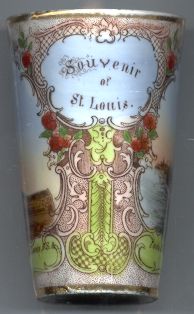
The second picture on tumbler no.B036 [below] shows the
 Municipal
Municipal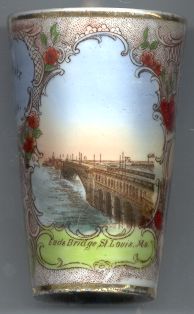
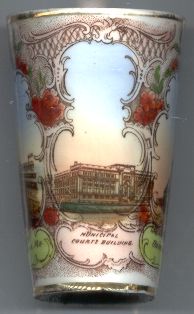
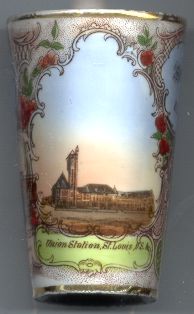
The Louisiana Purchase Exposition was a World's Fair held in Saint Louis, Missouri in 1904 and celebrated the centennial
of the Louisiana Purchase of 1803. The Fair opened on April 30, 1904, and closed on December 1 the same year.
The Fair Grounds covered 1,240 acres (500 hectares) in present-day Forest Park, the largest space of any fair, and it was probably the most grand
of the old style Pre-World War I Fairs. More than 1,500 individual buildings were connected by some 75 miles of roads and walkways.
The budget of the exhibition was astonishing $15 million dollars.
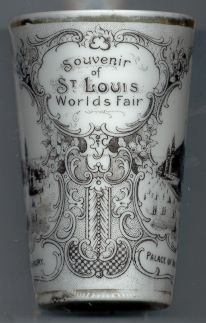
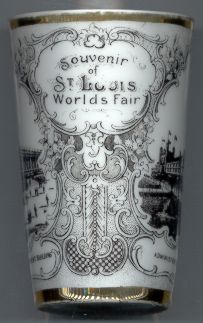 Exhibits were staged by 62 foreign nations, the United States government, 43 of the American states, in addition to the numerous exhibits
put on by many industries, cities, private organizations and corporations, theater troops, music schools, etc.
the fair also included exhibits of moer than 50 tribes from all over the world who were moved from their native homes to environments designed to
look like their homelands. A huge lake had to be built as a water supply. The fair also hosted the 1904 Summer Olympic Games.
Of all the World's Fairs, the St. Louis Louisiana Purchase Exhibition is said to be the only one to have resulted in a net profit.
Almost all of the fair buildings that had been constructed during three years before the opening of the fair were dismantled and demolished
within 6 months after the closure of the exhibition. The Art Museum, the Bird House (now part of St. Louis Zoo) and many lagoons and channels
in Forest Park are the only things that still remain today.
Exhibits were staged by 62 foreign nations, the United States government, 43 of the American states, in addition to the numerous exhibits
put on by many industries, cities, private organizations and corporations, theater troops, music schools, etc.
the fair also included exhibits of moer than 50 tribes from all over the world who were moved from their native homes to environments designed to
look like their homelands. A huge lake had to be built as a water supply. The fair also hosted the 1904 Summer Olympic Games.
Of all the World's Fairs, the St. Louis Louisiana Purchase Exhibition is said to be the only one to have resulted in a net profit.
Almost all of the fair buildings that had been constructed during three years before the opening of the fair were dismantled and demolished
within 6 months after the closure of the exhibition. The Art Museum, the Bird House (now part of St. Louis Zoo) and many lagoons and channels
in Forest Park are the only things that still remain today.
The 1944 movie "Meet Me in St. Louis", directed by Vincente Minelli and starring Judy Garland,
is set in St. Louis at the time of the Louisiana Purchase Exhibition. The film has been classified "culturally significant" by the
Library of Congress and selected for preservation in the United States National Film Registry.
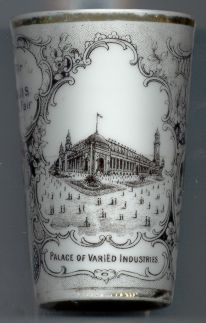
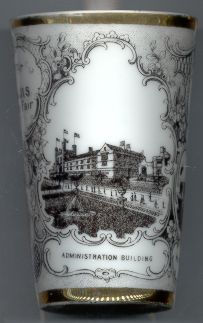
The  Palace of Varied Industries [left]
was crowned with Spanish steeples and had a semi-circular colonnade unlike anything ever before done in architecture.
The hexagonal building housed 34 different groups of exhibits within its 14 acres (4.7 ha), covering such topics as
industrial arts, furniture, jewelry, and interior design.
Palace of Varied Industries [left]
was crowned with Spanish steeples and had a semi-circular colonnade unlike anything ever before done in architecture.
The hexagonal building housed 34 different groups of exhibits within its 14 acres (4.7 ha), covering such topics as
industrial arts, furniture, jewelry, and interior design.
The first picture on tumbler no.B037 [right] shows
 Administration
Administration
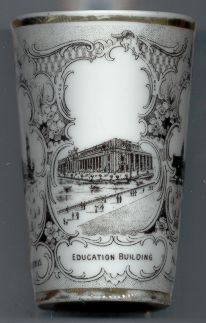
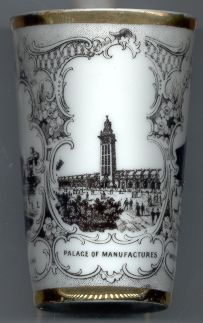
The  Palace of Education and Social Economy [left]
covered 7 acres (2.8 ha) and was surounded with a splendid Corinthian colonade.
It housed school classes ranging from kindergarten to university levels and included schools for the deaf and the blind.
Students attending the classes came from all over the world. There were also technical classes from Germany,
industrial schools from France, Austria and Italy, and art schools from Austria, Great Britain and Ireland.
The Louisiana Purchase Exhibition was the first international fair that included a building entirely devoted to education.
Palace of Education and Social Economy [left]
covered 7 acres (2.8 ha) and was surounded with a splendid Corinthian colonade.
It housed school classes ranging from kindergarten to university levels and included schools for the deaf and the blind.
Students attending the classes came from all over the world. There were also technical classes from Germany,
industrial schools from France, Austria and Italy, and art schools from Austria, Great Britain and Ireland.
The Louisiana Purchase Exhibition was the first international fair that included a building entirely devoted to education.
The  Palace of Manufactures [right]
housed the "shopping mall" of the fair. The hexagonal building, distinguished by colonnades and richly embellished loggias,
covered 14 acres (4.7 ha), included a large inner court and provided booths for retail merchants of over
900 industries from all over the world.
The United States Customs Office collected more than half a million dollars in duties on the foreign goods sold in this building.
Palace of Manufactures [right]
housed the "shopping mall" of the fair. The hexagonal building, distinguished by colonnades and richly embellished loggias,
covered 14 acres (4.7 ha), included a large inner court and provided booths for retail merchants of over
900 industries from all over the world.
The United States Customs Office collected more than half a million dollars in duties on the foreign goods sold in this building.
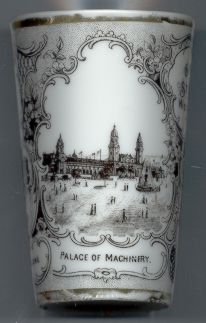
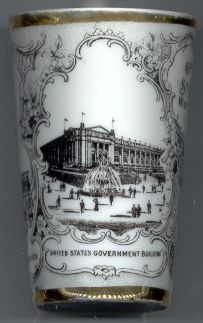
The  Palace of Machinery [left]
presented as a forest of towers – the two located at the entrance were 285 ft (87 m) high –
and a big sloping roof backing a sculpture-decked entrance way.
It exhibited the latest advancements in power generation – from steam boilers to electric generators –
and provided most of the power requirements for the fair. About 500 tons of coal were required each day to run the machines.
The most spectacular use for this energy was the grand illumination of the fair buildings and the cascades at night
with over half a million electric light bulbs and sweeping search lights of changing hues.
Palace of Machinery [left]
presented as a forest of towers – the two located at the entrance were 285 ft (87 m) high –
and a big sloping roof backing a sculpture-decked entrance way.
It exhibited the latest advancements in power generation – from steam boilers to electric generators –
and provided most of the power requirements for the fair. About 500 tons of coal were required each day to run the machines.
The most spectacular use for this energy was the grand illumination of the fair buildings and the cascades at night
with over half a million electric light bulbs and sweeping search lights of changing hues.
The third picture on tumbler no.B037 [right] shows
 United
United
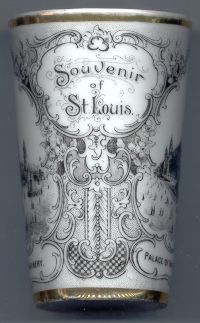
On tumbler no.B042 [below] the Palace of Education and Social Economy (see above) is (falsely) labeled "Palace of Textiles".
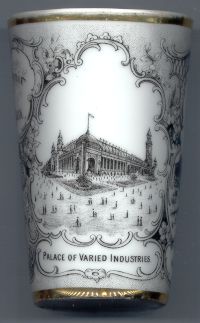
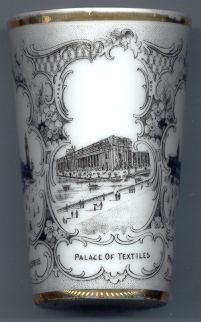
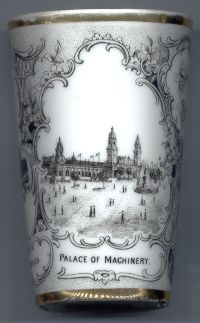
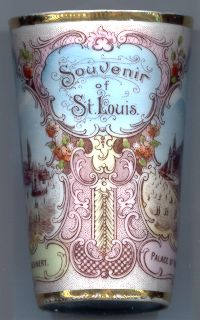
Tumbler no.B044 [below]:
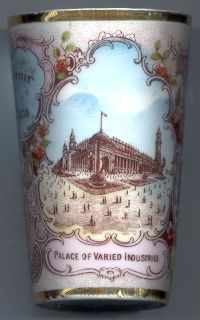
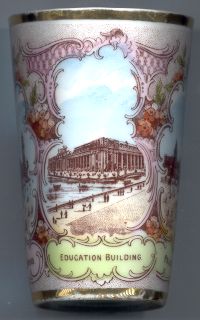
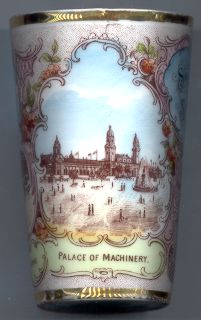
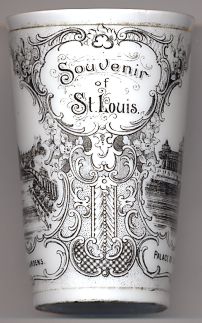
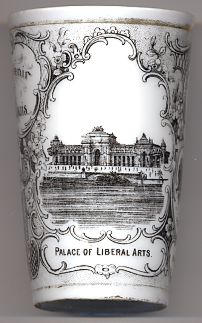
The first picture on tumbler no.B048 shows the
 Palace
Palace
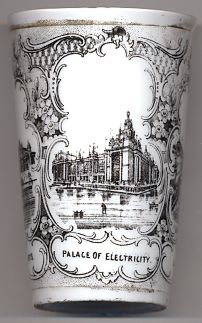
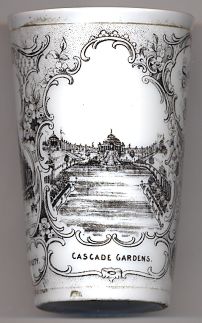
The  Palace of Electricity [left] covered 7 acres and was devoted to
the wonders of the then novel technology. Thomas Alva Edison was brought to the fair to oversee the proper setup of the
electrical exhibits. Telegraphs could be used to communicate with Chicago or Kansas City, and
telephones allowed communication with anybody throughout the country (provided they had a telephone as well).
One of the most popular exhibits was the "fast" food cooked with electricity.
Palace of Electricity [left] covered 7 acres and was devoted to
the wonders of the then novel technology. Thomas Alva Edison was brought to the fair to oversee the proper setup of the
electrical exhibits. Telegraphs could be used to communicate with Chicago or Kansas City, and
telephones allowed communication with anybody throughout the country (provided they had a telephone as well).
One of the most popular exhibits was the "fast" food cooked with electricity.
The  Festival Hall [right, background]
was crowned by a gold-leafed dome larger than the dome of St. Peter's Basilica in Rome.
The Festival Hall included an auditorium which seated 3,500 people, and also housed the world's largest organ with
10,159 pipes. After the fair, the organ was dismantled and loaded onto 13 railroad cars for shipment to its new home.
It was reassembled at Wanamaker's Department Store in Philadelphia, where it still retains its
title as the largest pipe organ in the world.
Festival Hall [right, background]
was crowned by a gold-leafed dome larger than the dome of St. Peter's Basilica in Rome.
The Festival Hall included an auditorium which seated 3,500 people, and also housed the world's largest organ with
10,159 pipes. After the fair, the organ was dismantled and loaded onto 13 railroad cars for shipment to its new home.
It was reassembled at Wanamaker's Department Store in Philadelphia, where it still retains its
title as the largest pipe organ in the world.
 Cascade
Cascade
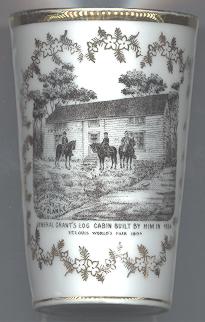
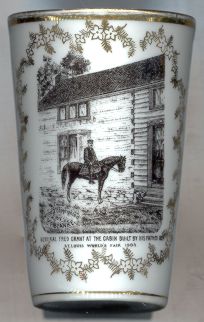
Grant's Farm is a 281 acre (114 ha) wildlife preserve and historical site located just south of the city of
St. Louis, Missouri and is owned by Anheuser-Busch, Inc. The Farm is home to hundreds of exotic animals from around the world.
In 1907 Adolphus A. Busch, father of August A. Busch Jr. of the well-known brewer dynasty, purchased a piece of Missouri
farmland once plowed and planted by Gen. (then Capt.) Ulysses S. Grant (1822–1885), 18th President (1869–1877) of the United States.
The  Log Cabin [left and right] was built by Grant himself in 1855. The cabin was later moved to Old Orchard, MO and was one of the exhibits at the
St. Louis World's Fair (Louisiana Purchase Exposition) in 1904. In 1907, A. Busch had the cabin moved and reassembled about one mile from its original location.
In 1977, Anheuser-Busch had the cabin restored to its present condition.
Log Cabin [left and right] was built by Grant himself in 1855. The cabin was later moved to Old Orchard, MO and was one of the exhibits at the
St. Louis World's Fair (Louisiana Purchase Exposition) in 1904. In 1907, A. Busch had the cabin moved and reassembled about one mile from its original location.
In 1977, Anheuser-Busch had the cabin restored to its present condition.
The pictures on the two tumblers [left, no.B004, and right, no.B021] also show Grant's eldest son, General Frederick Dent Grant (1850–1912), when he visited the log cabin at the Louisiana Purchase Exhibition in 1904.
![[scale]](lineal.jpg)